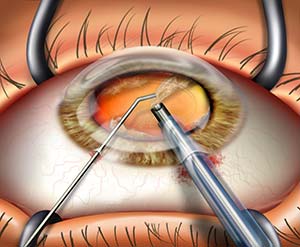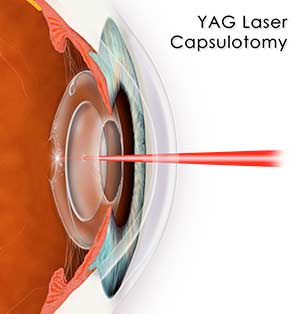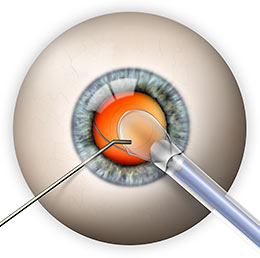Katarakt Cerrahisi

kataraktın erken bulguları yeni gözlüklerle, daha parlak ışıkla, yansımasız güneş gözlükleri ile telafi edilmeye çalışılabilir. Bu önlemler işe yaramayacak olursa tek etkili tedavi cerrahi olabilir. Ameliyat ile bulanıklaşmış olan lens alınarak suni mercek ile değiştirilir.
Görme kaybı, araç kullanma, okuma, TV izleme gibi günlük aktivitelerde sorun oluşturmaya başlamış ise kataraktın alınması gerekir. Siz ve göz doktorunuz bu kararı birlikte verebilirsiniz. Ameliyatın yararını ve risklerini öğrendikten sonra sizden aydınlatılmış onam alınacaktır. Olguların çoğunda ameliyatın geciktirilmesi gözlerinizde kalıcı hasar veya ameliyatı daha zor hale getirmeyecektir. Ameliyat kararı vermede acele etmeniz gereksizdir.
Bazen katarakt görmenizde sorun yaratmadığı halde alınması gerekebilir. Örneğin, Makuler dejenerasyon veya diyabetik retinopati gibi başka bir göz probleminin izlenmesi veya tedavisine engel olduğunda kataraktınızın alınması gerekebilir. Göz doktorunuz sizde katarakt tanısı koyduğu zaman yıllarca ameliyat olmanıza gerek olmayabilir. gerçektende belki hiç bir zaman ameliyat olmanıza gerek olmayabilir. Görmenizi düzenli olarak kontrol ettirirseniz ne zaman ameliyat olacağınızı doktorunuzla kararlaştırabilirsiniz.
Eğer iki gözünüzde de katarakt var ise herbir gözünüzün ameliyatı farklı zamanlarda olacaktır.
Kataraktı olan birçok kişide aynı zamanda yaşa bağlı makula dejeneresansı veya glokom gibi ilave başka bir göz rahatsızlığıda vardır. Kataraktınız dışında başka bir göz sorununuz varsa Dr Ilker Biçer ile konuşabilirsiniz. Risklerini, faydalarını, alternatiflerinizi ve ameliyattan neler bekleyebileceğinizi öğreniniz.
What are the different types of cataract surgery?
There are two types of cataract surgery. Your doctor can explain the differences and help determine which is better for you:

Phacoemulsification, or phaco.
A small incision is made on the side of the cornea, the clear, dome-shaped surface that covers the front of the eye. Your doctor inserts a tiny probe into the eye. This device emits ultrasound waves that soften and break up the lens so that it can be removed by suction. Most cataract surgery today is done by phacoemulsification, also called “small incision cataract surgery.”
After the natural lens has been removed, it often is replaced by an artificial lens, called an intraocular lens (IOL). An IOL is a clear, plastic lens that requires no care and becomes a permanent part of your eye. Light is focused clearly by the IOL onto the retina, improving your vision. You will not feel or see the new lens.
Some people cannot have an IOL. They may have another eye disease or have problems during surgery. For these patients, a soft contact lens, or glasses that provide high magnification, may be suggested.
What are the risks of cataract surgery?
As with any surgery, cataract surgery poses risks, such as infection and bleeding. Before cataract surgery, your doctor may ask you to temporarily stop taking certain medications that increase the risk of bleeding during surgery. After surgery, you must keep your eye clean, wash your hands before touching your eye, and use the prescribed medications to help minimize the risk of infection. Serious infection can result in loss of vision.
Is cataract surgery effective?
Cataract removal is one of the most common operations performed in the United States. It also is one of the safest and most effective types of surgery. In about 90 percent of cases, people who have cataract surgery have better vision afterward.
What happens before surgery?
A week or two before surgery, your doctor will do some tests. These tests may include measuring the curve of the cornea and the size and shape of your eye. This information helps your doctor choose the right type of IOL.
What happens during surgery?
At the hospital or eye clinic, drops will be put into your eye to dilate the pupil. The area around your eye will be washed and cleansed.
The operation usually lasts less than one hour and is almost painless. Many people choose to stay awake during surgery. Others may need to be put to sleep for a short time.
If you are awake, you will have an anesthetic to numb the nerves in and around your eye.
After the operation, a patch may be placed over your eye. You will rest for a while. Your medical team will watch for any problems, such as bleeding. Most people who have cataract surgery can go home the same day. You will need someone to drive you home.
What happens after surgery?
Itching and mild discomfort are normal after cataract surgery. Some fluid discharge is also common. Your eye may be sensitive to light and touch. If you have discomfort, your doctor can suggest treatment. After one or two days, moderate discomfort should disappear.
For a few days after surgery, your doctor may ask you to use eyedrops to help healing and decrease the risk of infection. Ask your doctor about how to use your eyedrops, how often to use them, and what effects they can have. You will need to wear an eye shield or eyeglasses to help protect your eye. Avoid rubbing or pressing on your eye.
When you are home, try not to bend from the waist to pick up objects on the floor. Do not lift any heavy objects. You can walk, climb stairs, and do light household chores.
In most cases, healing will be complete within eight weeks. Your doctor will schedule exams to check on your progress.
Can problems develop after surgery?

Problems after surgery are rare, but they can occur. These problems can include infection, bleeding, inflammation (pain, redness, swelling), loss of vision, double vision, and high or low eye pressure. With prompt medical attention, these problems can usually be treated successfully.
Sometimes the eye tissue that encloses the IOL becomes cloudy and may blur your vision. This condition is called an after-cataract. An after-cataract can develop months or years after cataract surgery.
An after-cataract is treated with a laser. Your doctor uses a laser to make a tiny hole in the eye tissue behind the lens to let light pass through. This outpatient procedure is called a YAG laser capsulotomy. It is painless and rarely results in increased eye pressure or other eye problems. As a precaution, your doctor may give you eyedrops to lower your eye pressure before or after the procedure.
When will my vision be normal again?
You can return quickly to many everyday activities, but your vision may be blurry. The healing eye needs time to adjust so that it can focus properly with the other eye, especially if the other eye has a cataract. Ask your doctor when you can resume driving.
If you received an IOL, you may notice that colors are very bright. The IOL is clear, unlike your natural lens that may have had a yellowish/brownish tint. Within a few months after receiving an IOL, you will become used to improved color vision. Also, when your eye heals, you may need new glasses or contact lenses.
